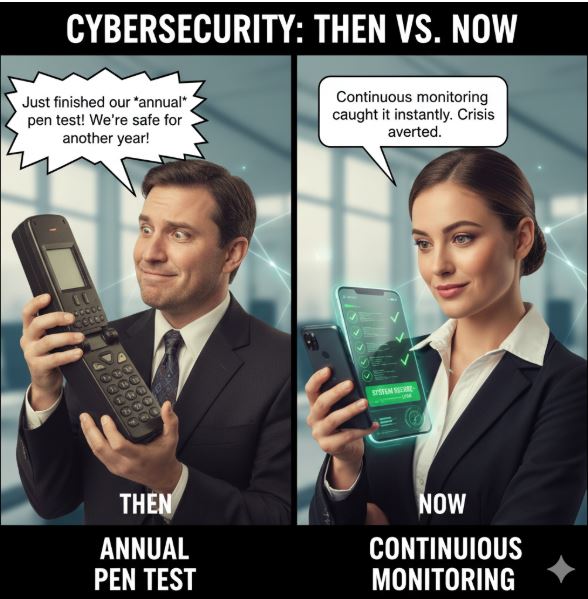For decades, companies have relied on penetration testing to measure the security posture of their systems. Think of a pen test as engaging a friendly hacker to meticulously probe your defenses. The tester employs various tactics and then provides a comprehensive report detailing vulnerabilities. This approach is akin to an annual health checkup: once a year, you undergo examinations, and your doctor provides an assessment of your well-being.
This methodology was largely effective in an era preceding widespread internet connectivity and rapidly evolving software. A company could conduct a pen test in January, address the identified weaknesses, and maintain a reasonable sense of security until the following year. However, the technological landscape has fundamentally transformed.

The Accelerating Pace of the Digital World
Today, our digital infrastructure from corporate servers and employee endpoints to personal mobile devices and even smart lightbulbs undergoes relentless updates. Operating systems like Microsoft Windows, for instance, release critical security patches and feature updates weekly, with major versions rolled out regularly. A study by IBM Security found that the average time to identify and contain a data breach was 277 days in 2022, highlighting the prolonged exposure businesses face to undetected vulnerabilities. Applications, from essential communication platforms like Zoom to sophisticated payroll software, update automatically, often in the background. Even the firmware embedded in network routers and smart devices is frequently revised to resolve bugs or introduce new functionalities.
Each software update, while often improving functionality or patching known flaws, is effectively a “small surgery” on your system. Sometimes, this surgical intervention is flawless. Other times, it inadvertently opens a new vulnerability a weakness that malicious actors can exploit. Relying solely on an annual pen test in this environment is akin to visiting your doctor once a year, despite your body constantly undergoing changes and facing new environmental stressors. By the time an annual test uncovers a problem, it may have already been present and exploited for months, potentially causing significant financial and reputational damage. The average cost of a data breach globally reached $4.35 million in 2022, a testament to the severe consequences of delayed detection.
The Imperative of Continuous Monitoring
This is precisely where continuous monitoring becomes indispensable. Instead of a 12-month interval between security assessments, companies can deploy sophisticated tools that meticulously observe their systems around the clock. These solutions are designed to detect anomalous behavior, such as a corporate workstation attempting to connect to a suspicious domain, or an employee’s device installing unauthorized or risky software.
The health metaphor remains highly relevant here. Consider individuals managing chronic conditions like high blood pressure or diabetes. While their primary care physician may schedule annual or semi-annual appointments, these are supplemented by regular, at-home monitoring using blood pressure cuffs or glucose meters. These frequent, smaller checks enable early detection of issues, allowing for prompt adjustments to medication or lifestyle and preventing acute crises.
Continuous cybersecurity monitoring operates on the same principle. It augments, rather than replaces, in-depth expert reviews, providing an early warning system that can prevent a minor security lapse from escalating into a full-blown crisis. Gartner predicts that by 2025, 60% of organizations will use cybersecurity risk quantification to drive business decisions, moving beyond simple compliance checklists to a more proactive, risk-aware posture.
A Strategically Balanced Approach
The most robust cybersecurity strategy integrates both proactive and continuous methodologies:
Penetration tests remain invaluable. They offer a deep, adversarial “outside-in” review akin to a comprehensive medical examination. This is particularly crucial for newly developed software systems, especially those engineered in-house or sourced from third-party vendors, where novel vulnerabilities are more likely to exist.
Continuous monitoring maintains a vigilant watch over your systems every day much like daily at-home health checks. This ensures that new vulnerabilities introduced by updates or changes in user behavior are identified promptly.
Together, these approaches equip your IT and security teams with the actionable intelligence needed to respond swiftly and effectively, staying ahead of evolving cyber threats. Organizations that adopt a continuous security validation approach can reduce their mean time to detect (MTTD) and mean time to respond (MTTR) to threats, thereby mitigating potential damage.
What Non-Technical Managers Should Remember
As a non-technical manager, you are not expected to master the intricacies of every security tool or software update. However, your role is critical in overseeing key aspects of your organization’s cybersecurity posture:
Patch Management Velocity: How efficiently and rapidly does your IT team apply critical security patches and updates as they become available? Unpatched vulnerabilities are a leading cause of breaches.
Probing Attack Monitoring: What mechanisms are in place for your IT team to monitor and detect probing attacks from malicious actors attempting to find weaknesses in your defenses?
Standardized Crisis Response Policy: Is there a clearly defined and regularly practiced crisis response policy in place for cybersecurity incidents? Time is of the essence during a breach.
Measuring System Health & Maintenance: How do you measure your IT team’s time and effectiveness in maintaining system health and ensuring continuous security?
Cybersecurity is no longer a sporadic, annual event. It is a fundamental, daily operational imperative. A healthy business, much like a healthy life, demands consistent vigilance.
Cybersecurity isn’t a yearly event anymore it’s a daily operation. Curious how managers can build this into everyday business decisions?
👉 Let’s connect and explore practical steps to protect your operations: roger.do@watchdogcyberdefense.com
